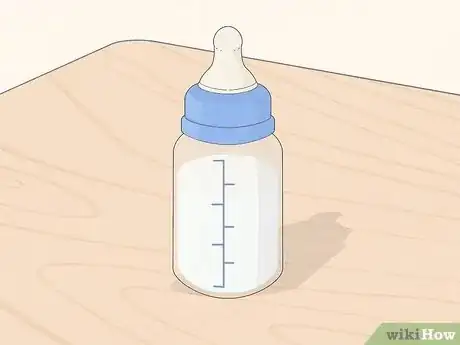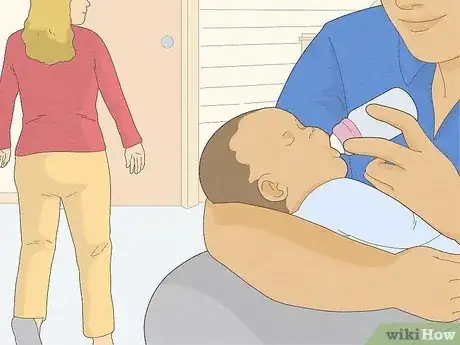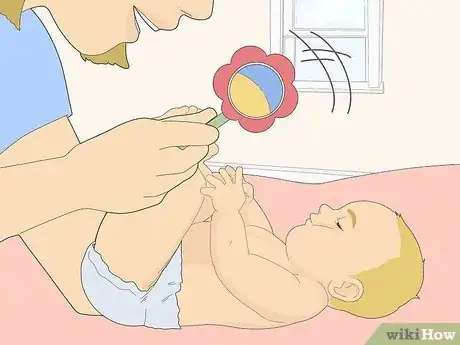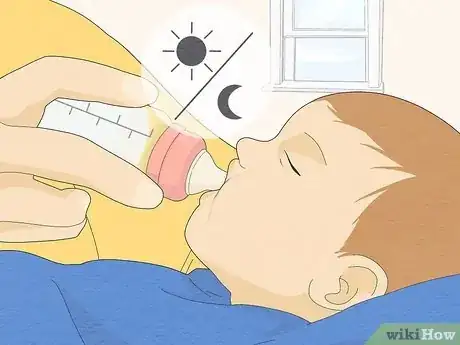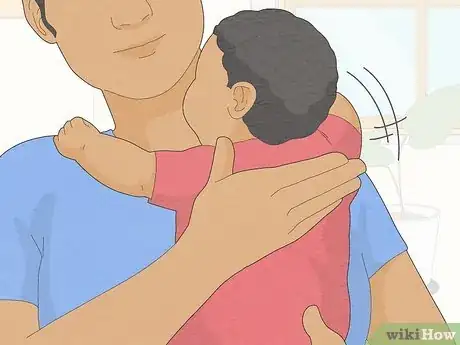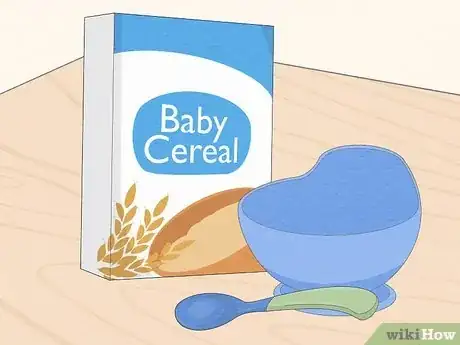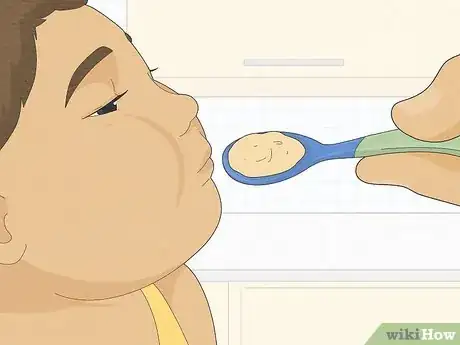This article was co-authored by Lora Luczywo, IBCLC. Lora Luczywo is an International board certified Lactation Consultant (IBCLC) based in Los Angeles, California. Lora has over 10 years of lactation consulting experience. She completed her lactation education at the University of California, San Diego and earned her clinical competency at Kaiser Permanente Los Angeles Medical Center and Torrance Memorial Medical Center. She has a BA in Liberal Arts and Sciences from the University of Arizona.
This article has been viewed 85,501 times.
Breast milk is the best food for babies. Until six months of age an exclusively breast-fed baby needs little else, and you introduce baby foods slowly after that. Many doctors recommend breastfeeding your child at least for a year. But if you need to wean your child before she is a year old, replacing breast feedings with bottle feedings, cup feedings, and food is your best option.
Steps
Weaning Your Baby
-
1Decide on a weaning schedule. You need to taper off gradually, not just immediately stop breastfeeding. Based on how long you have determined you have and then number of feedings you give your child per day, you will be able to figure out how to best wean your baby. It’s important to start slowly, both for you and the baby. He needs to get used to not breastfeeding, and your body needs to let down from producing milk.[1]
- Weaning can be very tough for both the mother and the baby — be mentally ready for a challenge.
-
2Start replacing breastfeeding with bottle feeding. The easiest way to start moving your baby away from being dependent upon breastfeeding is to move her onto drinking formula from a bottle. Babies should not drink milk until they are a year old — then you can let them drink milk from a bottle as well.[2] You can also try replacing breast feeding with formula in a cup if your baby seems ready. There are many options of cups meant for babies over six months old.
- Replace one of the feedings per day with a bottle.
- Start with her least favorite feeding.
- After a few days or longer, replace another feeding with a bottle feed.
- Continue replacing bottles for times you typically breastfeed.
EXPERT TIPLora Luczywo is an International board certified Lactation Consultant (IBCLC) based in Los Angeles, California. Lora has over 10 years of lactation consulting experience. She completed her lactation education at the University of California, San Diego and earned her clinical competency at Kaiser Permanente Los Angeles Medical Center and Torrance Memorial Medical Center. She has a BA in Liberal Arts and Sciences from the University of Arizona.International Board Certified Lactation Consultant
 Lora Luczywo, IBCLC
Lora Luczywo, IBCLC
International Board Certified Lactation ConsultantTry shortening each nursing session and spacing them out gradually. When you're trying to transition your baby from breastfeeding, slowly begin to space out the feedings. For instance, you can time the feedings, then shave off 1-2 minutes every 2 or 3 days. Also, begin to space them out a little further. If you've been feeding every 3-4 hours, you might start spacing that out to every 5-6 hours.
Advertisement -
3Stay out of the room for the bottle feeding. Babies can smell milk and understand when you’re near. Get someone else to do the feeding when you can.
Changing Routines
-
1Avoid making the act of not breastfeeding a big issue. Babies can take different amounts of time to finally stop breastfeeding. If you withhold the breast from the baby and she is gesturing her desire for it (licking lips, placing hands on your breast) it might make it into an issue when it wasn’t before. Try distracting her before she can start getting interested in breastfeeding at times when she typically wants to nurse.[3]
-
2Work on phasing out the night feedings. Breastfeeding your baby at night and in the early morning are often the most difficult habits to break. Many babies find it very comforting to fall asleep right after breastfeeding, or eat immediately upon waking. Some children might take easily to a bottle instead of the breast, but many like the comfort and closeness of breastfeeding and will resist switching to a bottle.[4]
- Try holding your baby in the same position as you do when breastfeeding when you try to give him a bottle.
-
3Start a new bedtime routine. Rather than the feedings being what you and your baby do to snuggle down, think about other ways she could relax. Some of the ways you can try to get your baby to sleep include:
- Singing to your baby
- Reading books to your baby
- Patting your baby’s back
Feeding the Baby Solid Foods
-
1Find good solid foods to supplement your baby’s nutritional intake. If your baby is over six months old, it’s time to begin solid foods. Any earlier, and babies’ heads and necks tend to not be strong enough to support swallowing solids. Some foods are particularly good when weaning your baby. Weaning foods are complementary in nature — that is, they complement mother’s milk. The basic purpose of introducing these foods is: a) to provide taste and variety to the baby’s diet; b) to provide the “missing” nutrients; c) to teach the baby swallowing, chewing and eating skills; and d) to habituate the baby to the exact taste and flavor of home meals.[5]
- Begin with liquids, then go on to semi-solids and finally to normal home foods. By the age of ten months, the baby should be eating an almost full diet.
- Most pre-made baby foods have "stages" of foods to help you decide which foods to start with. Many parents start with rice or other grain cereals and go on to vegetables or fruits next.
-
2Do not expect the baby to swallow much food. He is still learning to chew/swallow the food, and there will be times when the baby seems to be “refusing” the food, or even “throwing” it back out, when actually, he is just unable to co-ordinate his mouth and tongue movements sufficiently enough to put the food inside.
- Start with just one to two tablespoons of solid food and increase over time as you baby wants more.
-
3Begin the weaning process with just one food. Give this food daily for the first three to four days. Ensure that she is able to eat it, digest it and remain free from any allergic symptoms like coughing, loose bowel movements, or rashes. After the four days or so are up, start with another new item. A food item that does not agree with the baby can be re-tried after some weeks as long as it doesn't cause hives, wheezing, swelling, or trouble breathing.
- In cases of families with a history of food allergies, atopic eczema, drug intolerance etc, new foods should be tried with caution.
Warnings
- Babies should not be given tea, coffee, soft drinks, chocolate, boiled sweets, hard nuts, or any small food items can get inhaled into the lungs.⧼thumbs_response⧽
References
- ↑ http://www.mayoclinic.org/healthy-lifestyle/infant-and-toddler-health/in-depth/weaning/art-20048440
- ↑ http://www.mayoclinic.org/healthy-lifestyle/infant-and-toddler-health/in-depth/weaning/art-20048440
- ↑ http://www.mayoclinic.org/healthy-lifestyle/infant-and-toddler-health/in-depth/weaning/art-20048440
- ↑ http://www.mayoclinic.org/healthy-lifestyle/infant-and-toddler-health/in-depth/weaning/art-20048440
- ↑ http://www.mayoclinic.org/healthy-lifestyle/infant-and-toddler-health/in-depth/healthy-baby/art-20046200
About This Article
To wean your baby from breastfeeding, start by replacing one breastfeeding a day with bottled formula milk, since babies need to make the change gradually. After a few days, replace a second feeding a day with formula milk. Continue replacing breastfeedings with formula milk until your baby is only drinking from the bottle. If you can, get your partner or someone else to feed your child from the bottle, since babies can smell breastmilk and may resist the formula if you try to feed them yourself. For more tips from our Medical co-author, including how to start feeding your baby solid foods, read on!

